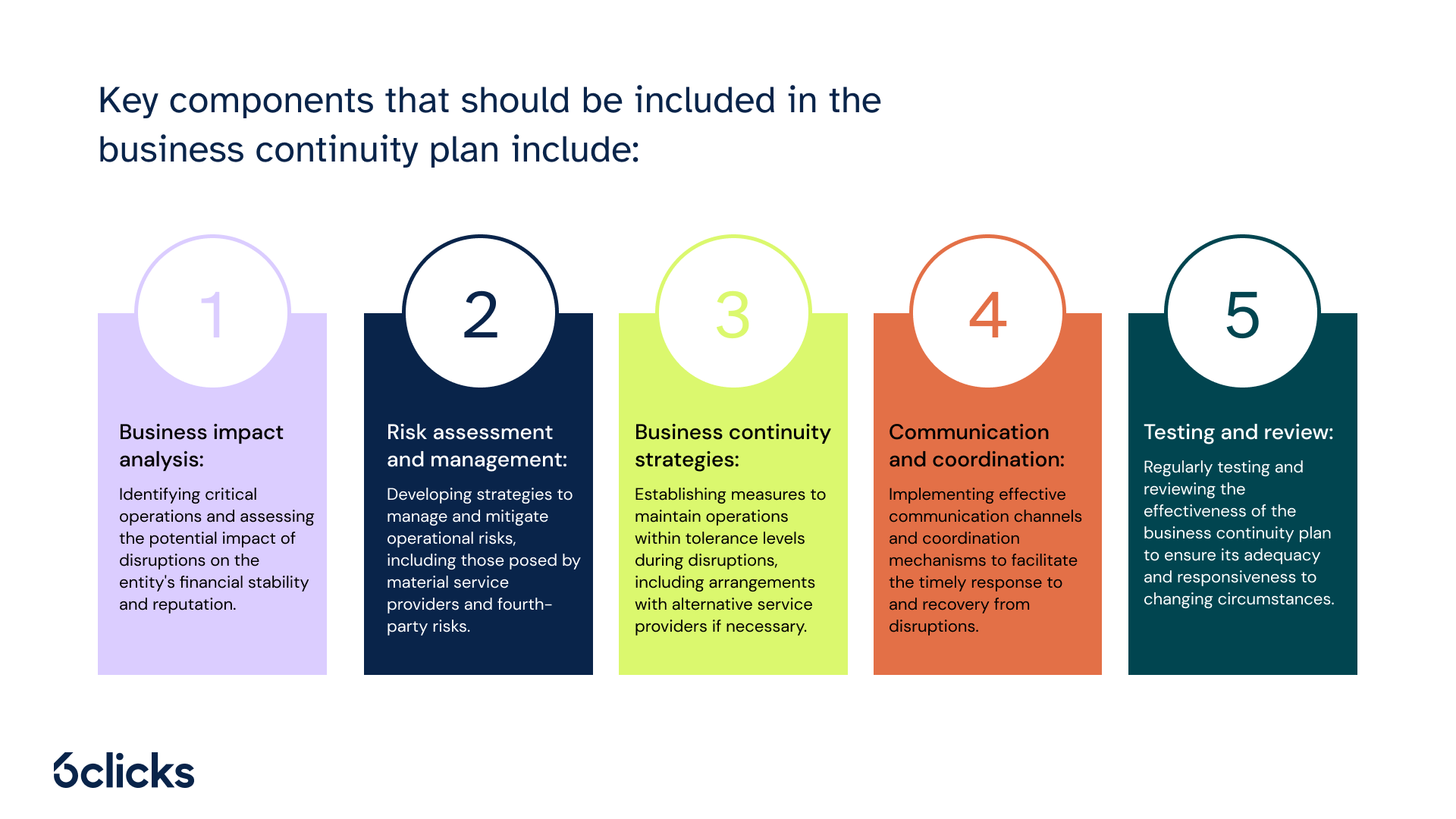Overview of APRA CPS 230
APRA CPS 230, also known as the Prudential Standard CPS 230 Operational Risk Management, is a set of guidelines and requirements outlined by the Australian Prudential Regulation Authority (APRA) for apra-regulated entities. It focuses on promoting effective operational risk management within financial institutions, including superannuation funds. This standard emphasizes the need for entities to identify, assess, and manage operational risks, ensuring the resilience of critical operations and the protection of consumers. It covers various aspects, such as the management of material service providers, operational risk incidents, business continuity planning, internal controls, and compliance obligations. APRA CPS 230 sets forth minimum standards and regulatory requirements that APRA-regulated entities must adhere to in order to mitigate operational risks and maintain the continuity of business operations within tolerance levels. It also includes provisions for the management of third and fourth-party risks, termination provisions for pre-existing contractual arrangements, and the reporting of material operational risks to APRA. Overall, APRA CPS 230 aims to enhance operational resilience and minimize the adverse impacts of operational disruptions in the financial services industry.
Purpose of APRA CPS 230
APRA CPS 230, the prudential standard on operational risk management, business continuity planning, and third-party risk management, plays a crucial role in strengthening the resilience of apra-regulated entities.
The purpose of CPS 230 is to enhance the operational risk management framework, ensuring that critical operations and material business activities within the financial services industry are carried out effectively. It focuses on minimizing operational risk incidents and their adverse impacts, while promoting operational resilience.
One key consideration for implementing CPS 230 is the proactive transition period. During this period, APRA-regulated entities are required to identify their material service providers and establish arrangements to manage these relationships effectively. This includes evaluating pre-existing contractual arrangements and ensuring they align with the requirements of CPS 230.
Additionally, entities must set tolerance levels for their operational risk profile, which determine the acceptable thresholds for operational disruptions. These tolerance levels help organizations identify the areas that require significant improvements and prioritize their resources and senior management accordingly.
By implementing CPS 230, APRA-regulated entities are better equipped to manage operational risks, strengthen their business continuity planning, and enhance their management of third-party risks. This prudential standard ensures that operations are conducted within tolerance levels, minimizing the impact of severe disruptions and providing greater assurance to customers and stakeholders.
Understanding operational risk management
Operational risk management is a crucial aspect of running a successful financial services entity. It involves identifying, assessing, and mitigating risks that may arise from internal processes, people, systems, or external events. Prudential Standard CPS 230 sets out the framework for effective operational risk management, ensuring that critical operations and material business activities within the industry are carried out with minimal disruptions and adverse impacts. This standard requires entities to establish arrangements with their material service providers, evaluate and align pre-existing contractual arrangements, and set tolerance levels for operational disruptions. By understanding and implementing operational risk management practices in accordance with CPS 230, financial institutions can enhance their operational resilience, minimize the likelihood and impact of operational risk incidents, and ensure compliance with regulatory requirements.
Definition of operational risk management
Operational risk management is a crucial element for APRA-regulated entities, as it aims to enhance resilience to operational risks and disruptions. It involves the identification, assessment, and management of operational risks to ensure the ongoing stability and continuity of critical operations.
The first step in operational risk management is the identification of potential risks and vulnerabilities that could impact the organization's ability to function effectively. This includes assessing risks associated with internal processes, systems, and human resources, as well as risks associated with external factors, such as service providers.
Once risks are identified, they are assessed to determine their potential impact and likelihood of occurrence. This allows organizations to prioritize their risk management efforts and allocate appropriate resources for mitigation.
Managing operational risks involves implementing controls to reduce the likelihood and impact of risks, as well as monitoring the effectiveness of these controls. Regular monitoring and evaluation of remediation efforts are crucial to ensure continuous improvement in risk management practices.
During severe disruptions, such as natural disasters or cyber-attacks, maintaining critical operations within tolerance levels is essential. This requires effective business continuity planning and the ability to quickly adapt and respond to unexpected events.
Operational risk management also entails effectively managing material risks associated with service providers. This involves establishing pre-existing contractual arrangements and formal agreements with service providers, setting clear expectations and requirements for business continuity, and actively monitoring and managing service provider risks.
By adopting an integrated and proactive approach, operational risk management helps APRA-regulated entities to mitigate and manage the adverse impacts of operational risks, ensuring the stability and resilience of their business operations.
Components of operational risk management
Operational risk management involves several key components that organizations must address to effectively identify, assess, and manage operational risks. This ensures that critical operations are maintained within tolerance levels during disruptions and that service provider arrangements are properly managed and monitored.
The first component is the identification of operational risks. This involves identifying potential risks and vulnerabilities that could impact the organization's ability to function effectively. This includes assessing risks associated with internal processes, systems, and human resources, as well as risks associated with external factors, such as service providers.
Once identified, the next component is the assessment of operational risks. Organizations must assess the potential impact and likelihood of occurrence of these risks. This allows them to prioritize their risk management efforts and allocate appropriate resources for mitigation.
Managing operational risks is the next crucial component. This involves implementing controls to reduce the likelihood and impact of risks. It requires establishing internal controls and compliance obligations, as well as actively monitoring the effectiveness of these controls. Regular monitoring and evaluation of remediation efforts are crucial to ensure continuous improvement in risk management practices.
In the face of disruptions, such as natural disasters or cyber-attacks, maintaining critical operations within tolerance levels becomes essential. Organizations need to implement business continuity plans and have the ability to quickly adapt and respond to unexpected events. This ensures that the impact of disruptions is minimized, and critical operations are maintained.
Another important component is the effective management of risks associated with service providers. This involves establishing pre-existing contractual arrangements and formal agreements with service providers. It includes setting clear expectations and requirements for business continuity and actively monitoring and managing service provider risks.
Implementing a service provider management policy is essential for ensuring that service providers meet the organization's requirements and effectively manage any risks that may arise. This policy includes measures for assessing service provider's operational risk profile, conducting due diligence, and establishing termination provisions in case of non-compliance.
In conclusion, operational risk management consists of several components that organizations must address. This includes identifying and assessing risks, implementing controls to manage risks, monitoring the efficacy of remediation efforts, maintaining critical operations during disruptions, and effectively managing risks associated with service providers. By following these components, organizations can mitigate operational risks and ensure the smooth functioning of their operations.
Impact of failing to manage operational risk properly
Failing to manage operational risk properly can have significant consequences for an APRA-regulated entity and its operational resilience. Without an effective operational risk management framework, organizations are exposed to material operational risks that can pose severe disruptions to their critical operations.
Operational risks can arise from various sources, such as internal processes, systems, human resources, and external factors like service providers. Failure to identify and assess these risks can leave an organization vulnerable to potential operational failures and financial losses.
Severe disruptions to critical operations can occur if adequate risk mitigation measures are not in place. This can include prolonged system outages, information security breaches, business interruptions, or regulatory non-compliance, which can have far-reaching consequences. These disruptions can lead to reputational damage, customer dissatisfaction, financial losses, and even potential regulatory sanctions.
Furthermore, failing to manage operational risk effectively undermines an APRA-regulated entity's operational resilience. The ability to respond and recover from operational disruptions is crucial for maintaining business continuity and safeguarding the interests of stakeholders. Without proper operational risk management, an organization may struggle to adapt and resume critical operations, resulting in prolonged recovery periods and increased vulnerability to future disruptions.
In conclusion, the impact of failing to manage operational risk properly can be detrimental to an APRA-regulated entity. Increased exposure to material operational risks, severe disruptions to critical operations, and compromised operational resilience can have adverse effects on an organization's reputation, financial stability, and ability to meet regulatory requirements. It is imperative for organizations to implement an effective operational risk management framework as outlined in APRA CPS 230 to mitigate these risks and promote operational resilience.
Pre-existing contractual arrangements with service providers
Pre-existing contractual arrangements with service providers play a significant role in operational risk management for APRA-regulated entities. These arrangements refer to contracts and agreements that are already in place between an organization and its service providers. They cover a broad range of services and activities, such as technology infrastructure, data processing, customer support, and investment management. These contractual arrangements must be carefully reviewed and managed to ensure that operational risks associated with these service providers are effectively identified, assessed, and mitigated. It is crucial for organizations to assess the operational risk profile of their service providers and establish minimum standards for their performance and compliance obligations. By closely monitoring and managing their relationships with service providers, organizations can enhance operational resilience and minimize the potential for disruptions that can have a material impact on their business operations.
Identifying material service providers
Identifying material service providers is a crucial step in complying with APRA CPS 230, which focuses on operational risk management in the financial services industry. Determining the materiality of a service provider involves assessing the level of risk they pose to the operations of an APRA-regulated entity.
Several criteria and factors should be considered when evaluating whether a service provider is material. These include the nature and complexity of the services they provide, the criticality and importance of those services to the APRA-regulated entity's business operations, the potential impact of any disruptions caused by the service provider, and any regulatory requirements that need to be fulfilled.
To identify and assess material service providers, the following steps should be taken. Firstly, the APRA-regulated entity must compile a comprehensive list of all service providers they rely on. Then, they should evaluate the criticality and importance of the services provided by each service provider. This assessment should consider the potential severity and frequency of security incidents that could arise from the service provider's activities.
Additionally, the entity should review any pre-existing contractual arrangements in place with the service provider, ensuring compliance with APRA's operational risk standards. Finally, a comprehensive service provider management policy should be established, outlining the processes for ongoing monitoring, risk assessment, and performance evaluation of material service providers.
By diligently following these steps and considering the criteria and factors mentioned above, APRA-regulated entities can effectively identify and assess material service providers, mitigating operational risks and ensuring operational resilience in their business operations.
Assessing existing contractual arrangements with service providers
Assessing existing contractual arrangements with service providers involves a thorough review of the terms and conditions outlined in the agreements to identify any gaps or deficiencies. This process ensures that the agreements are compliant with APRA's operational risk standards and meet the entity's specific requirements.
The first step is to carefully analyze the terms and conditions of each contract, paying close attention to key provisions such as the scope of services, performance expectations, termination provisions, and dispute resolution mechanisms. This assessment helps identify any inconsistencies, omissions, or ambiguities that may pose risks to the APRA-regulated entity's operations.
Furthermore, it is crucial to evaluate the performance of the service providers in meeting the agreed-upon service levels. This assessment involves analyzing their track record, responsiveness, and ability to deliver services effectively. If service-level targets are not being met, it may indicate the need for remedial actions or contract revisions.
In addition to performance evaluation, the efficacy of risk controls implemented to manage operational risks associated with service providers should be assessed. This evaluation includes examining the service providers' internal controls, security measures, business continuity plans, and compliance with regulatory requirements. Any deficiencies or weaknesses in these areas need to be addressed promptly to mitigate operational risks.
By thoroughly assessing existing contractual arrangements with service providers, APRA-regulated entities can identify any gaps or deficiencies that may pose risks to their business operations and take appropriate actions to ensure compliance and operational resilience.
Identifying gaps in existing arrangements and transitional requirements
Identifying Gaps in Existing Arrangements and Transitional Requirements with Service Providers
When it comes to managing operational risks, APRA CPS 230 emphasizes the importance of thoroughly assessing and managing the risks associated with service providers. This includes identifying any gaps in existing contractual arrangements and determining the transitional requirements needed to ensure compliance with the prudential standard.
Firstly, it is crucial to evaluate the current contractual agreements with service providers to identify any gaps or inconsistencies that may exist. This involves a comprehensive review of the terms and conditions, scope of services, termination provisions, and dispute resolution mechanisms. Any gaps in these arrangements can pose significant risks to the APRA-regulated entity's operations and need to be addressed promptly.
In line with CPS 230, transitioning to compliant contractual arrangements is essential. This means identifying the actions needed to close the identified gaps and bring the contracts in line with the prudential standard. This may involve negotiating or amending existing contracts, establishing new contracts, or implementing additional control measures to mitigate risks effectively.
It is also crucial to assess the financial and other risks associated with relying on service providers. This includes considering not only the risks associated with the service providers themselves but also the risks associated with any fourth parties involved. Implementing appropriate risk minimization measures is vital to safeguard the interests of the APRA-regulated entity and ensure compliance with the prudential standard.
Overall, identifying gaps in existing arrangements and determining transitional requirements are crucial steps in ensuring operational risk management in compliance with APRA CPS 230. Regular assessments and proactive actions in managing contractual arrangements and associated risks contribute to the operational resilience and continuity of APRA-regulated entities.
Prudential Standard CPS 230 requirements for business continuity planning and management
The Prudential Standard CPS 230 sets out the requirements for business continuity planning and management for APRA-regulated entities. This standard is crucial in ensuring the operational resilience of entities across various industries, including the superannuation industry. It focuses on identifying and managing operational risks, including those related to third-party service providers and major disruption. By implementing effective business continuity plans and management practices, entities can minimize the adverse impact of operational risk incidents and maintain their operations within tolerance levels. The standard also emphasizes the need for entities to evaluate and manage the risks associated with pre-existing contractual arrangements and establish formal agreements with material service providers to ensure compliance with regulatory requirements. By adhering to CPS 230, entities can enhance their operational resilience and protect the interests of their customers and stakeholders.

Requirements for business continuity planning and management
APRA CPS 230, the prudential standard for operational risk management, places significant emphasis on the need for effective business continuity planning and management within APRA-regulated entities. This standard requires entities to identify their critical operations and establish tolerance levels for each operation, taking into consideration the potential financial impact on depositors, policyholders, beneficiaries, and customers.
To meet these requirements, an APRA-regulated entity must develop a comprehensive business continuity plan that addresses the maintenance of essential operations during disruptions. This plan should outline the steps to be taken to mitigate the impact of disruptions and ensure continuity of the entity's key functions. It should also specify the processes to notify APRA if disruptions occur outside of the established tolerance levels.
Key components that should be included in the business continuity plan include:
- Business impact analysis: Identifying critical operations and assessing the potential impact of disruptions on the entity's financial stability and reputation.
- Risk assessment and management: Developing strategies to manage and mitigate operational risks, including those posed by material service providers and fourth-party risks.
- Business continuity strategies: Establishing measures to maintain operations within tolerance levels during disruptions, including arrangements with alternative service providers if necessary.
- Communication and coordination: Implementing effective communication channels and coordination mechanisms to facilitate the timely response to and recovery from disruptions.
- Testing and review: Regularly testing and reviewing the effectiveness of the business continuity plan to ensure its adequacy and responsiveness to changing circumstances.
By adhering to the requirements of APRA CPS 230 and implementing robust business continuity planning and management processes, APRA-regulated entities can enhance their operational resilience and better protect their critical operations, ensuring the continued provision of essential services to customers.
Developing a business continuity plan (BCP)
Developing a Business Continuity Plan (BCP) for an APRA-regulated entity in compliance with CPS 230 requires careful consideration of key requirements and processes.
Firstly, it is crucial to document critical operations and identify potential disruptions that may have an adverse impact on the entity's operations. This includes assessing the involvement of material service providers and understanding their processes for maintaining operational resilience.
Next, setting a risk appetite for disruptions is essential in determining the tolerable level of impact an entity can withstand without compromising its business operations. This includes defining tolerance levels for each critical operation and establishing arrangements with alternative service providers if needed.
Furthermore, implementing a systematic testing program is crucial to verify the effectiveness of the BCP. Regular testing and review help ensure that the plan is up to date and responsive to changing circumstances. Testing should include scenarios that simulate various operational risk incidents to assess the readiness of the entity and its service providers in managing disruptions.
By developing a comprehensive BCP that includes documenting critical operations, understanding service provider processes, setting risk appetite for disruptions, and implementing a systematic testing program, APRA-regulated entities can enhance their operational resilience and effectively manage operational risks as required by CPS 230.
Establishing Ongoing Business Continuity Management Processes
Establishing ongoing business continuity management processes in accordance with APRA CPS 230 involves several important steps.
Firstly, entities must develop a comprehensive business continuity plan (BCP) that outlines how critical operations will be maintained in the event of disruptions. This includes identifying potential risks and documenting the steps required to ensure operational resilience. Entities must also establish arrangements with material service providers and document their processes for maintaining operational resilience.
Next, entities need to develop a systematic testing program to validate the effectiveness of their BCP. This program should include regular testing and reviewing of the plan to ensure it remains up to date and responsive to changing circumstances. Testing should simulate various operational risk incidents to assess the readiness of the entity and its service providers in managing disruptions.
Additionally, entities must document the processes of their service providers to assess their ability to maintain operational resilience. This documentation ensures that entities have a thorough understanding of their service providers' capabilities and can make informed decisions regarding their ongoing relationships.
The testing requirements deepened in the standard include the need for entities to conduct regular, comprehensive tests of their BCP. This includes testing the plan against a range of scenarios that simulate different operational risk incidents. The standard also emphasizes the importance of reviewing and updating the plan based on the results of testing to ensure its ongoing effectiveness.
Superannuation Industries and Operational Resilience
The superannuation industry plays a crucial role in ensuring the financial wellbeing of individuals in their retirement years. As such, it is imperative for entities operating in this industry to have robust operational resilience measures in place. Operational resilience refers to the ability of an entity to withstand and recover from disruptions while ensuring the continuity of critical operations.
Operational resilience is closely linked to operational risk management. Operational risk refers to the potential for financial loss resulting from inadequate or failed internal processes, people, and systems or from external events. By focusing on operational resilience, entities in the superannuation industry can proactively identify and address operational risks, minimizing the potential for financial harm.
Operational resilience goes beyond traditional concepts of business continuity and business resilience. While business continuity focuses on the ability to continue operations during disruptions, operational resilience takes a more holistic approach. It involves not only the ability to recover from disruptions but also the capacity to adapt and quickly restore critical operations without causing financial harm.
Regulated entities in the superannuation industry must adhere to specific steps to ensure operational resilience. They must work within tolerance levels set for operational risks, which define the acceptable level of impact from potential disruptions. By maintaining operations within these tolerance levels, entities can minimize the adverse impact of disruptions on their financial stability.
Conducting scenario testing is also crucial in ensuring operational resilience. Regulated entities need to simulate various operational risk incidents to assess their readiness and identify areas for improvement. Through comprehensive testing, entities can ascertain the effectiveness of their operational resilience measures and make necessary adjustments.
Explore the 6clicks solution for vendor risk management here to help with alignment with APRA CPS 230.
Written by Anthony Stevens
Ant Stevens is a luminary in the enterprise software industry, renowned as the CEO and Founder of 6clicks, where he spearheads the integration of artificial intelligence into their cybersecurity, risk and compliance platform. Ant has been instrumental developing software to support advisor and MSPs. Away from the complexities of cybersecurity and AI, Ant revels in the simplicity of nature. An avid camper, he cherishes time spent in the great outdoors with his family and beloved dog, Jack, exploring serene landscapes and disconnecting from the digital tether.









